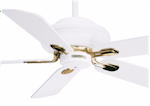
How they Work
Installation Tips
Ceiling fans can provide substantial savings on energy. Using about the same electricity as a 100-watt light bulb you can run one for just pennies a day. By themselves in mild weather, ceiling fans offer a low-cost alternative to air conditioning. If you use air conditioning, a ceiling fan will allow you to raise the thermostat setting about 4°F with no reduction in comfort. In temperate climates, or during moderately hot weather, ceiling fans may allow you to avoid using your air conditioner altogether.
 | How they work When it's warm, the blades of a turning ceiling fan normally push air downward, causing cool air near the floor to travel outward and mix with air at the edges of the room. If you use it in the summer, however, keep in mind that it does little good to run it when you're not around. The fan really isn't cooling the room. Like a breeze on a hot summer day, it's the blowing air moving across your body that makes you feel cooler. |
The same cooling effect caused by blowing air currents keeps many people from using their ceiling fans in winter. But most fans have a switch on the motor housing that changes the direction in which the blades turn. Instead of forcing air downward, the blades will push air up toward the ceiling, where hot air normally rises, and drive it back down around the edges of the room. That can result in more even heating. And better heat circulation will help to combat the problem of sweating windows that some homes experience in the wintertime because of condensation on the glass.
Ceiling fans can help solve other cold weather problems as well. For example, some two-story houses have open stairways. Since heat rises, the upstairs can get hot, while the downstairs -- where the thermostat normally is -- can stay cold. As a result, the furnace can run more often and heating is uneven. But mounting a ceiling fan at the top of the stairway will mix the air more evenly, making the house much more comfortable and cutting down on heating costs. It's another example of how -- in summer and in winter -- fans can help you increase the comfort of your home while you decrease your monthly energy bills.
Installation Tips
Install a fan in each room that needs to be cooled during hot weather. Fans work best when the blades are 7 to 9 feet above the floor and 10 to 12 inches below the ceiling. Fans should be installed so their blades are no closer than 8 inches from the ceiling and 18 inches from the walls. Larger ceiling fans can move more air than smaller fans. A 36- or 44-inch diameter fan will cool rooms up to 225 square feet, while fans that are 52 inches or more should be used in larger rooms. Multiple fans work best in rooms longer than 18 feet. Small- and medium-sized fans will provide efficient cooling in a 4- to 6-foot diameter area, while larger fans are effective up to 10 feet. A larger blade will also provide comparable cooling at a lower velocity than a smaller blade. This may be important in areas where loose papers or other objects will be disturbed by a strong breeze. The fan should also be fitted to the aesthetics of the room—a large fan may appear overpowering in a small room.
|
|
|
| Copyright Aclara Technologies LLC. All Rights Reserved. | |